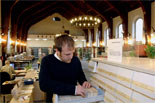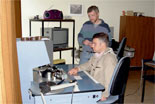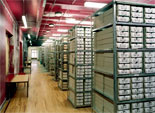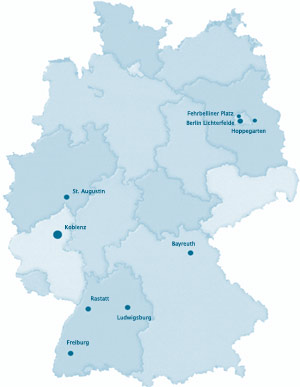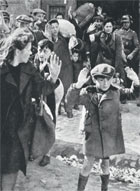
Berlin
The Bundesarchiv (Federal Archives) in Berlin-Lichterfelde is the facility with the largest personnel and building volume. With rising usage, this branch houses the collections of the Abteilung Reich (Reich Archives) including the records, holdings, and collections of the Nazi era relating to individuals taken over from the Berlin Document Center, the holdings of the GDR departments as well as the archive and library holdings of the Foundation on Archives of Parties and Mass Organizations of the GDR (SAPMO).
Since 1990, the facility at Fehrbelliner Platz in Berlin- Wilmersdorf has housed the now reunified Film Archives from East and West Germany. At the moment, the Film Archive is responsible for the indexing and use of films and film related material. After the completion of the new repository and renovation of the administration building at the Berlin-Lichterfelde site, this location on Fehrbelliner Platz will be closed.
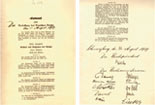
First and last pages of the Constitution of the German Reich (Weimar Constitution) from 11 August 1919, with corrections made by hand and signatures.
St. Augustin
This archive was built in 1971 on the site of the Bundespolizei (Federal Police) in St. Augustin-Hangelar. In 1979 it was extended with a functional repository to serve as a temporary storage facility for the ministerial documents of the higher federal authorities in Bonn. It houses 43 km of documents.
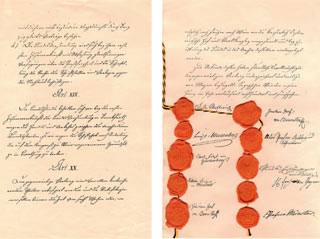
Final article of the German Federal Acts (Deutschen Bundesakte) from 8 June 1815, with seals and signatures.
Koblenz
The main office of the Bundesarchiv is in Koblenz. The President of the Bundesarchiv, Abteilung Z (responsible for central administration tasks), Abteilung G (responsible for fundamental archival issues) and Abteilung B (responsible for documents from West Germany and the agencies of the western zones of occupation) are located here. Furthermore, in Koblenz it is possible to use all the holdings of the collections of the German Reiches from 1495 to 1867.
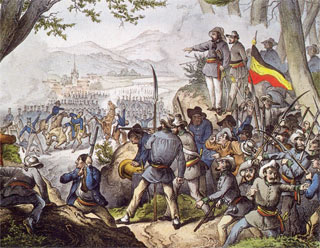
Color lithograph from 1848, showing the death of General Friedrich von Gagern in the battle at Scheideck bei Kandern on 20 April 1848.
Rastatt
In 1974, at the suggestion of Gustav Heinemann, the German Federal President at that time, the Bundesarchiv opened the memorial exhibition "Freedom Movements in German History" in the palace Schloss Rastatt. Every year, nearly 20,000 people, many of which are students, visit the exhibition about the German struggle for freedom, democracy and unity from early modern times till the peaceful revolution in 1989/90.
Freiburg
The Military Archive department in Freiburg is responsible for the records of the German forces since 1867, the Federal Ministry of Defense including the Army, and the East German Ministry of National Defense, National People's Army and Border Troops.
Hoppegarten
Since 1991, the Bundesarchiv has been using the site of the former encryption center of the East German Ministry for State Security in Hoppegarten. Initially used as a collection point for the documents of the disbanded GDR authorities, since 1997 it has been expanded to serve as a temporary archive for the federal authorities in Berlin.
In 2005, a special archive was built for the storage of celluloid (including nitrocellulose) film as well as a functional building to house the technical workshops for handling, restoring and copying film. In addition, since 2001, the company Neschen AG has established a facility where the PH-balance of up to 24,000 sheets of paper a day is neutralized and damaged paper restored, thus saving the documents from further deterioration.
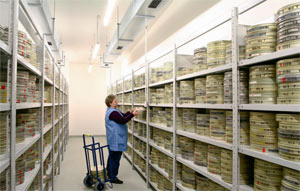
Storage of nitrocellulose film, which is subject to the laws regarding explosive materials (German Law on Explosives), in a special climate-controlled facility in Hoppegarten.
Bayreuth
The Lastenausgleich (the system of financial compensation for losses suffered in the Second World War) archive in Beyreuth holds over 46 km of documents related to the study of the flight and expulsion of Germans at the end of World War II, regional history and genealogy in the former East as well as the social and composite history of the Federal Republic of Germany.
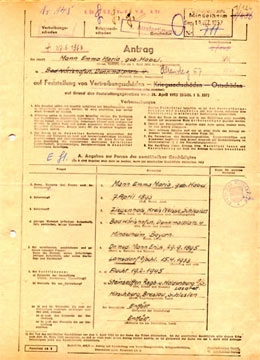
An application for the assessment of damages due to the flight and expulsion of Germans at the end of World War II.
Ludwigsburg
In Ludwigsburg in 1958, the shared facilities of state judicial administrations established the Zentrale Stelle (ZSt) (Central Location) for the investigations of Nazi war crimes. Since 2000, this facility has been a branch of the Bundesarchiv and displays here a permanent exhibition on the judiciary investigation of the war crimes.
